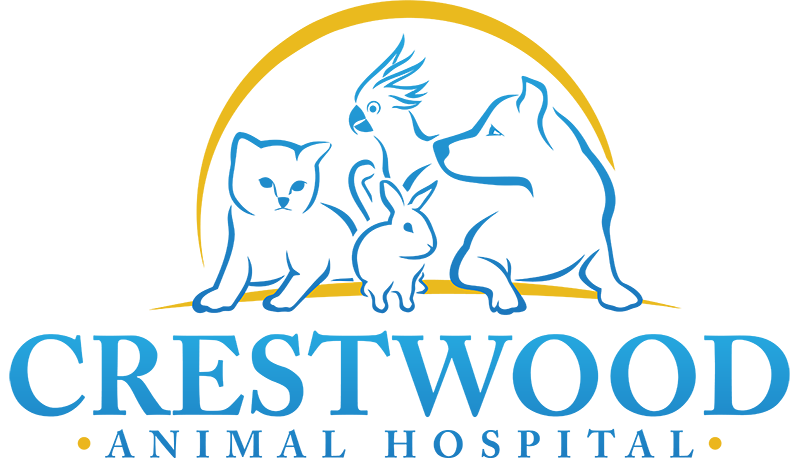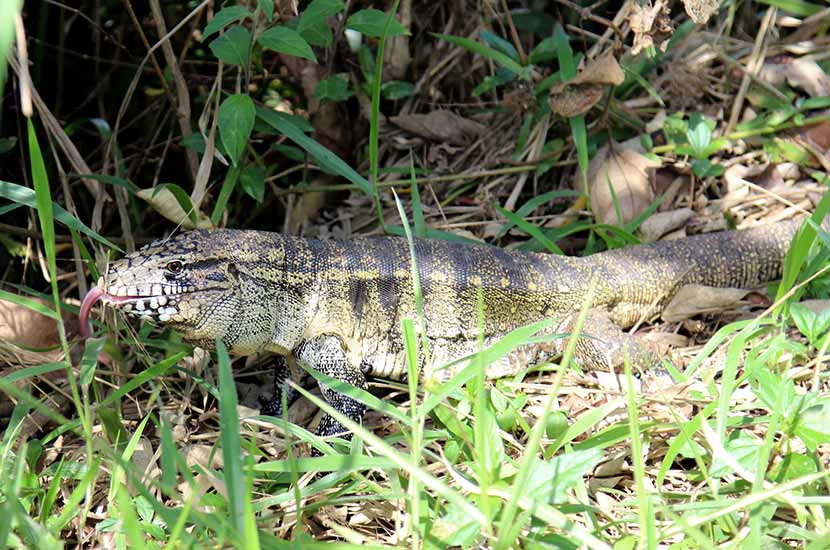Erica Mede, CVT
Description
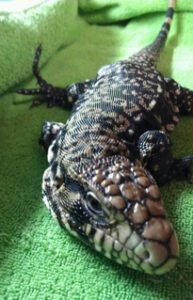 Tegus are potentially the most intelligent reptile and exhibit this intelligence by attempting clever escape routes. When handled regularly, these large bodied, stocky lizards can become quite docile and even enjoy physical interaction. Although tegus appear similar to monitor lizards there are a few key differences. The necks of tegus are generally shorter and much thicker. Tegus have a tapering snout with forked tongues that aren’t as deeply grooved as a monitor.
Tegus are potentially the most intelligent reptile and exhibit this intelligence by attempting clever escape routes. When handled regularly, these large bodied, stocky lizards can become quite docile and even enjoy physical interaction. Although tegus appear similar to monitor lizards there are a few key differences. The necks of tegus are generally shorter and much thicker. Tegus have a tapering snout with forked tongues that aren’t as deeply grooved as a monitor.
Unlike monitors, tegus are capable of tail autonomy (“tail dropping”)! This should be taken into consideration when dealing with flighty sub-adults and any new wild caught individual. Males are generally larger than females and exhibit large jowls, although, some females have smaller versions of jowls if they are on the slightly obese side. Most tegus reach a size of 4-5 feet from snout to tail tip and live around 10-15 years (some have reached 20!) with maturity around 3 years old.
Natural History
Tegus are found throughout South America (depending on the species). These large lizards inhabit the rainforests, savannahs, and grasslands (flat lands) and can be found near human residents as well. Frequently, tegus can be found in clearings in forests.
Feeding and Diet
In the wild, adult tegus are omnivores consuming animal protein, insects, and fruits. Vegetables can always be offered but tegus typically prefer to avoid greens and some even have trouble digesting them. In captivity, there have been many discussions on what works best as a diet for these lizards and historically, many have been kept on pure whole prey diets. These aggressive eaters will consume nearly anything placed in front of them and truly are primarily meat eaters. However, variety and balance are key to keeping a healthy tegu. Hatchlings and juveniles are primarily insectivores in the wild but in captivity can be taught to eat other foods as well.
Hatchlings should be fed every day with a strong focus on gut loaded insects. Crickets, dubia roaches, giant meal worms, and earth worms should make up the bulk of the diet. Pinkie mice can be offered once a week but it is recommended to wait until the hatchling tegus are a bit larger and older. Small amounts of boiled or cooked eggs and small amounts of fish can be offered as well to round out the meal and offer variety. Fruits can be offered along with the insects or pinkies and are encouraged for enrichment.
Tegus under 3 years old should still be fed every other day until they reach sexual maturity and roughly adult size. Whole prey such as mice “hoppers” and “fuzzies” make excellent feeders for smaller tegus whereas the larger ones can be fed various adult mice sizes. Cooked or boiled eggs, fish pieces, earth worms, roaches, giant or super meal worms, and other insects should be added to the diet. Again, fresh fruits should be offered.
Adults should be fed every 2-3 days depending on their body condition (obese tegus will eat less often than under weight tegus). The bulk of an adult tegu’s diet should consist of rodents, small rats, and the occasional baby chick. Insects, eggs, and fish should all be offered as well. Pieces of cooked chicken can be offered as a treat for enrichment as well as training in some individuals. Fresh fruits should be offered in moderation to prevent excessive weight gain from high sugar concentrations.
There are various methods and recipes for feeding tegus and commercial diets are an easy option for most keepers. A primary diet of Mazuri Carnivore is recommended with the addition of Mazuri Tortoise diet. Some have had great success with the addition of moistened Purina Trout Chow. Lean ground turkey is a welcome addition to any tegu diet as long as it is not the bulk of the diet. Tomatoes and bananas should be fed in moderation or avoided in general as these tend to cause gastrointestinal upset in captive tegus. All tegus should have their meals dusted with a calcium supplement and a multi-vitamin supplement used once to twice a week. An interesting note is the Red tegus have been known to eat a larger amount of fruit than their other counterparts.
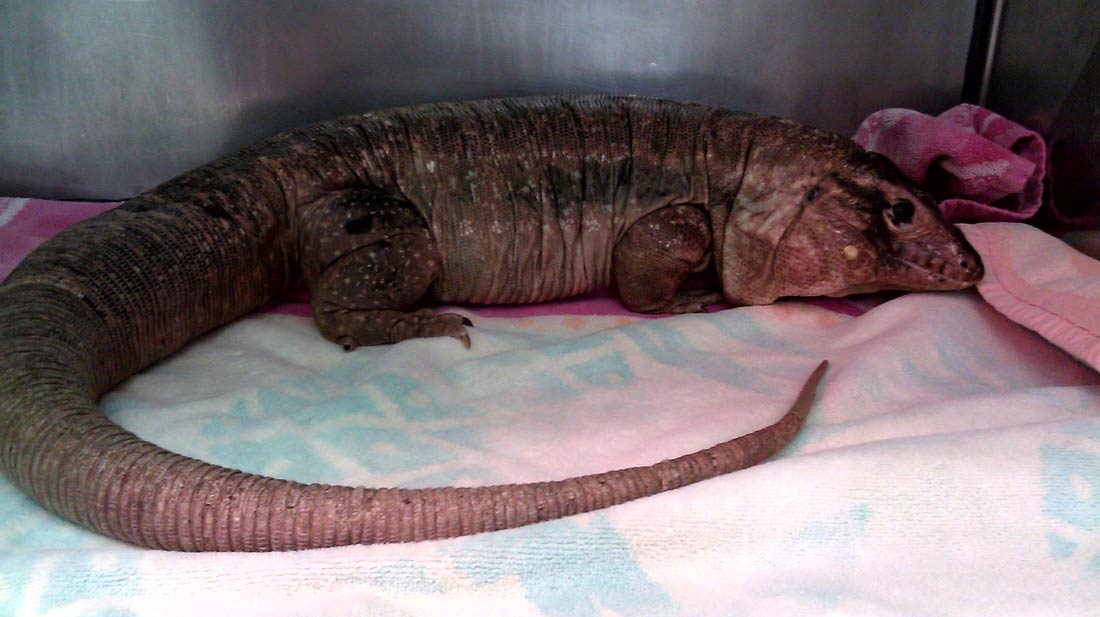
Enclosure
These lizards are typically ground dwellers although they can climb low level branches. Tegus are burrowers by nature and are excellent swimmers as well! A soak in a large bin or tub twice a week will give your tegu plenty of exercise and naturalistic enrichment. Hatchlings can be easily housed in a 20 gallon aquarium or enclosure of a similar size although they will quickly require larger accommodations. As tegus grow they will need a 40 gallon tank or larger (keeping in mind floor space is important) or a custom enclosure. Once your tegu hits 1-2 years old it is recommended to create a custom enclosure that is 6-8 feet long, 3-4 feet deep, and 3 feet high at least. Tegus require space to roam and sprawl out! Make sure that all enclosures are sturdy and escape proof. A locking door is recommended especially for wild caught or aggressive adults especially.
Substrate
There are numerous substrates to offer tegus in their enclosure ranging from complicated naturalistic set-ups to simplistic newspaper. Newspaper, although unattractive to look at, is easily cleaned out and tegus genuinely seem to appreciate hiding under the layers of paper. Butcher paper can be used as a uniform color alternative. Since tegus enjoy burrowing and will spend most of their time hidden under the substrate if allowed, seem to benefit from the addition of dig boxes. Dig boxes are designated areas or enclosed sections of top soil that can go as much as 2 feet deep! These boxes allow the tegu to fulfill natural desires to dig as well as offer another form of enrichment. Entire enclosures can be covered in top soil but it is hard to clean out effectively and tends to accumulate missed feces as well as offer feeder insects escapes from hungry tegus.
If particulate substrate is desired, aspen is a safe alternative. In this author’s humble opinion, the most enrichment can be achieved by covering the bottom of an enclosure with indoor/outdoor carpet and offering a top soil covered section of the cage (preferably with a lip to keep the soil from covering the rest of the cage). This not only offers multiple substrates to walk on but also offers the keeper ease of cleaning especially if a cement mixing tub or similar is used for the dig spot. All substrates should be changed at least every 2 weeks completely and spot cleaned daily. Tegus housed on particulate bedding or soil should be fed in a dish or a separate bin especially if live feeder insects are used.
Lighting
UVB lighting is typically not required for the care of tegus especially those fed whole prey diets. However, improper diet can lead to calcium deficiencies and the addition of an ultraviolet B radiation bulb such as a ReptiSun 5.0 is recommended. It is recommended to offer tegus exposure to ReptiSun 5.0 during day light hours.
Heating
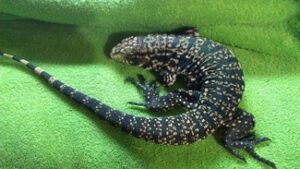 Tegus can happily be housed in ambient temperatures ranging from 73°F on the cooler end of the enclosure and 85°F on the warmer end of the enclosure. Ambient temperatures can easily be maintained utilizing under tank heaters, heat cable (only on the outside of the enclosure), heat tape, heat bulbs, ceramic heat emitters, and heat emitting panels. The basking site should be maintained between 95°F and 100°F ideally. At night, the enclosure should never fall below 72°F. Be warned, hibernation can occur below 65°F.
Tegus can happily be housed in ambient temperatures ranging from 73°F on the cooler end of the enclosure and 85°F on the warmer end of the enclosure. Ambient temperatures can easily be maintained utilizing under tank heaters, heat cable (only on the outside of the enclosure), heat tape, heat bulbs, ceramic heat emitters, and heat emitting panels. The basking site should be maintained between 95°F and 100°F ideally. At night, the enclosure should never fall below 72°F. Be warned, hibernation can occur below 65°F.
All heat sources should ideally be kept on a thermostat that allows for proper gradients while offering piece of mind to owners as well. A thermometer should be placed ideally one inch above the substrate on the cooler end of the enclosure. Another thermometer should be placed once inch above the substrate on the warmer end of the enclosure and the one last thermometer at the basking site.
Humidity
Coming from the rainforests of South America , these lizards should be maintained at 70-80% relative humidity. This can easily be monitored using a hygrometer. Humidity can be maintained with large water bowls or bins, misting systems, foggers, humidifiers in large enclosures, and spraying the enclosure 2-3 times a day. Moist topsoil, if offered, will also help preserve the humidity.
Enrichment
Finding ways to keep tegus entertained and active is as simple as wrapping earthworms or a piece of fish in a lettuce leaf or as complicated as modifying wiffle balls to hold roaches or fruit for them to move around. Creativity is essential for excellent tegu keeping. Tree trunks, tree branches, and root stocks make excellent obstacles, hides, and climbing surfaces for tegus. Make sure that all climbing surfaces are more horizontally angled as they are not necessarily agile climbers especially as they get older. Dig boxes are essential for working out extra energy and allowing for natural behaviors. Large soaking basins or twice weekly soaks in a kid pool or large rubber maid offers enrichment and another way to exercise tegus. Hide boxes are also a requirement for tegus, especially those that do not have anything to burrow into or hide under. Although it is offering a place to retreat, this is a form of enrichment as well. The addition of straw and hay in the enclosure allows the tegus to experience new smells and sensations as they walk and dig through it.
Sources and Recommended Readings
Lizards Volume 2, Manfred Rogner
General Care and Maintenance of Popular Monitors, Michael Balsai
Reptile Medicine and Surgery 2nd Edition, Doug Mader
Monitors, Tegus, and Related Lizards, Patricia Bartlett
Giant Lizards, Robert Sprackland
If you have any questions, please feel free to call us at (502) 241-4117.
